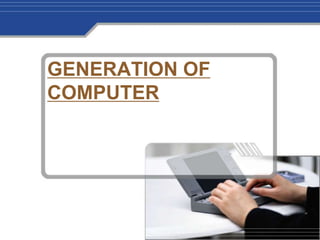
Generation of computer
- 2. Generation refer to the state of improvement in the product development process. Similarly, we can say generation of computer refers to the state of improvement of computer technlogy.
- 3. Programmable machine that can store, retrieve, and process data. Today's computers have at least one CPU that performs most calculations and includes a main memory, a control unit, and an arithmetic logic unit. Increasingly, personal computers contain specialized graphic processors, with dedicated memory, for handling the computations needed to display complex graphics, such as for three-dimensional simulations and games. Auxiliary data storage is usually provided by an internal hard disk and may be supplemented by other media such as floppy disks or CD-ROMs. Peripheral equipment includes input devices (e.g., keyboard, mouse) and output devices (e.g., monitor, printer), as well as the circuitry and cabling that connect all the components
- 4. i. The First Generation : 1946-1958 ( The Vacuum Tube Years) ii. The Second Generation of Computer : 1959- 1964 (The Era Of The Transistor) iii. The Third Generation of Computer : 1965- 1970 (Integrated Circuits – Miniaturizing the Computer) iv. The Fourth Generation of Computer : 1971- Today (The Microprocessor)
- 5. The First Generation Computer period starts from 1946 with ENIAC (Electronic Numerical Integrator And Computer) and UNIVAC (Universal Automatic Computer) developed by Presper Eckert and John Mauchly. Language used in first generation computer was the Machine Language. They were very large and prodeced a large amount of heat and they had to be cooled down by air conditioners. However even with these huge coolers, vacuum tubes still overheated regularly. It was time for something new. First-generation digital computers, developed mostly in the U.S. after World War II, used vacuum tubes and were enormous
- 6. Electron tube consisting of a sealed glass or metal enclosure from which the air has been withdrawn. It was used in early electronic circuitry to control a flow of electrons. In the first half of the 20th century, vacuum tubes allowed the development of radio broadcasting, long-distance telephone service, television, and the first electronic digital computers, which were the largest vacuum-tube systems ever built. Transistors have replaced them in virtually all applications, but they are still occasionally used in display devices for television sets and computers (cathode-ray tubes), in microwave ovens, and as high-frequency transmitters on space satellites.
- 7. Features of The First Generation : i. It is very slow. ii. It is very expensive. iii. It is very huge(as big as the size of the room). Limitation of The First Generation : i. Produce lot of heat. ii. Not Reliable. iii. Programming capacity was very slow. iv. Used machine language only.
- 8. The second generation, introduced c. 1960, used transistors and were the first successful commercial computers. The language used in the second generation computer was assembly language. The second generation computers also produced a large amount of heat and they too had to be cooled down by air conditioners They were smaller, faster and more efficient than the first generation computers. The operating speed was comparatively high. Examples of second generation computer were IBM140, MARK III, LEO, etc.
- 9. Features of The Second Generation: i. Electronic component used Transistor. ii. The size became smaller than first generation computer. iii. The operating speed became higher. iv. The cost became low. Limitation of The Second Generation : i. It produce heat. ii. Its speed was still low. iii. Memory was less.
- 10. The Third Generation of Computer : 1965- 1970 (Integrated Circuits – Miniaturizing the Computer) Third-generation computers (late 1960s and 1970s) were characterized by miniaturization of components and use of integrated circuits. Due to the use of ICs, the size of the computer became very small. Transistor were miniaturized and placed on silicon chip called semiconductor. High level languages like FORTRAN and COBOL were used. Example of third generation computer are ICL, CDC, IBM360, ICL 1900, etc.
- 11. Features of The Third Generation : i. The Electron component used integrated circuits ii. The size became much smaller. iii. The operating spedd became faster. iv. The cost became cheaper than their predecessors.
- 12. The microprocessor chip, introduced in 1974, defines fourth-generation computers. The size of computer became too small as thousands of integrated circuits were built onto a single chip. The Fourth Generation of Computer could fit on a small desk or in the palm of the hand. The Fourth Generation of Computer became more powerful and they could be linked together to form a network, which led the development of internet. Today’s Fourth Generation Computer are still getting smaller and more powerful. Example of fourth generation computer are Intel 4004, Apple, IBM 370, etc.
- 13. Features of The Fourth Generation of Computer : i. The Electron component used Microprocessor. ii. The size became much smaller than ever. iii. The operating spedd became very faster. iv. They are completely reliable.
- 14. Miniature electronic device that contains the arithmetic, logic, and control circuitry needed to function as a digital computer's CPU. Microprocessors are integrated circuits that can interpret and execute program instructions as well as handle arithmetic operations. Their development in the late 1970s enabled computer engineers to develop microcomputers. Microprocessors led to “intelligent” terminals, such as bank ATMs and point-of-sale devices, and to automatic control of much industrial instrumentation and hospital equipment, programmable microwave ovens, and electronic games. Many automobiles use microprocessor-controlled ignition and fuel systems.
- 15. Fourth-generation computer programming language. 4GLs are closer to human language than other high-level languages and are accessible to people without formal training as programmers. They allow multiple common operations to be performed with a single programmer-entered command. They are intended to be easier for users than machine languages (first-generation), assembly languages (second-generation), and older high-level languages (third-generation).
- 16. Thank you Name : Mukul Class : XIth
